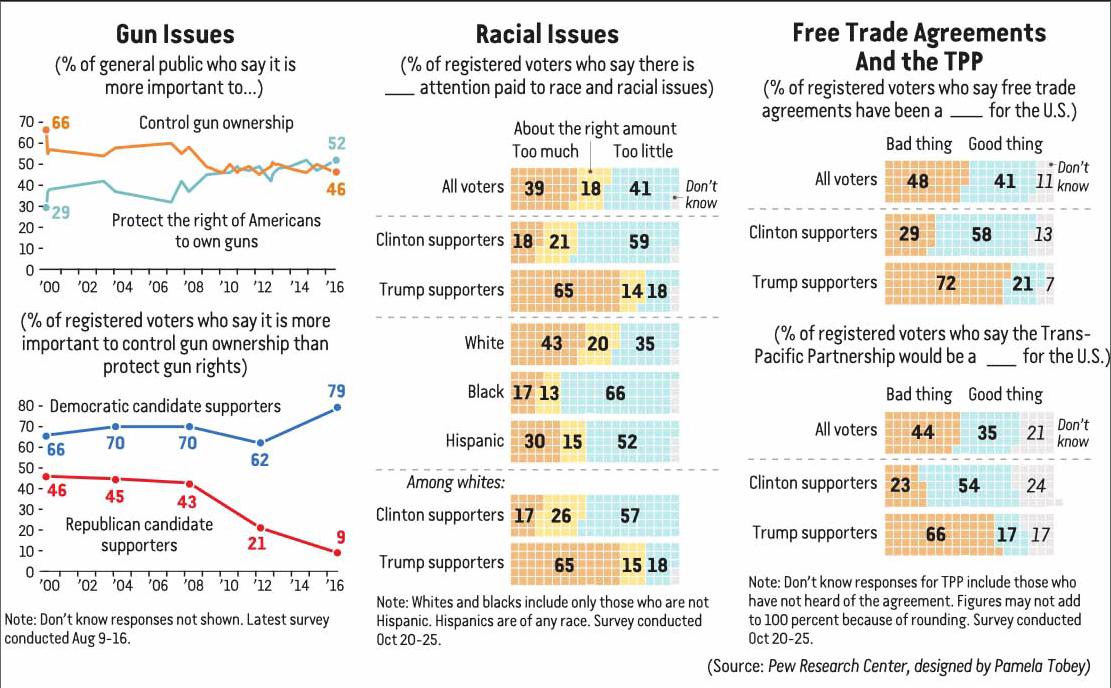MIXING FACTS WITH FICTION
2016-12-21ByRickDunham
By+Rick+Dunham


As the bitterest, most bizarre presidential campaign in modern American history lurched toward an inglorious end, some of the most influential U.S. media outlets continued their tough coverage of Republican presidential nominee Donald Trump. In the final days before the election, The Wall Street Journal, a business and commerce newspaper, reported that a political ally of Trump had paid $150,000 to hush allegations of an affair between Trump and a Playboy magazine model. The Associated Press, the nations largest news service, alleged in an exclusive report that Trumps immigrant wife Melania had been illegally paid for modeling before she received government authorization to work in the United States. And BuzzFeed News, a widely shared online news source, published a stunning report that Macedonian teenagers were being paid to write false news stories and “aggressively pro-Trump content” for more than 100 U.S. websites.
Trump, as has been his practice throughout the campaign, flatly denied all charges and blamed them on desperate Democrats and hostile, biased reporters who he claimed were conspiring with the Hillary Clinton campaign to deny him the presidency. “The media has been unbelievably dishonest,” he stated in a September interview broadcast on the Russian-owned television network RT.
Regardless of honest fact-checkers or dishonest partisans, the 2016 presidential campaign marked a painful pivot point for an American media establishment struggling to remain profitable amid a splintered market share and, for most, declining revenues.
News media upheaval
The coverage of the unconventional Republican nominee in what is widely known as the “mainstream media”—the United States most prominent newspapers, wire services, broadcast news networks, and a host of Internet startups and big data search engines—was relentlessly negative. Former New York Mayor Rudy Giuliani, a top Trump surrogate, told Fox News that Clinton didnt even need to campaign. “She has an entire media empire that constantly demonizes Donald Trump,” he complained.
And yet, as the election campaign drew to a close, Trump remained standing, and managed to pull off a victory against a scandal-weakened opponent who led throughout the race but could never pull away. This was in spite of constant criticism directed toward Trumps outrageous and false assertions on the campaign trail, and investigative reports on his questionable business practices and abusive treatment of women.
Not since the early days of the American republic, when U.S. newspapers were organs of the political factions that developed into the modern two-party system, has media coverage of a presidential race been as polarized and as relentlessly negative. A splintered news media, wracked by economic reversal and struggling to compete in an Internet-driven world of free information and commentary, abandoned decades of operating under a principle of neutrality as referees of fact.
As a result, one media wing focused on portraying one candidate as a habitual liar and serial sex offender, while a competing faction consistently reported on the other being a crooked career politician who would bring shame to the Oval Office.
The news medias upheaval is one of five fundamental shifts in American society that have contributed to the rise of Trump. The other key elements are:
—an increasingly diverse population that left some white voters feeling that their historical grip on power was loosening;
—a wave of immigration from Latin America and Asia that has provoked a backlash from some Americans who felt that the basic fabric of America was changing;
—a growing and widespread distrust of basic American institutions; and
—heavy job losses in the manufacturing sector tied to globalization that left certain regions of the country and a wide swath of less educated workers in economic despair, and a sharp shift in public attitudes on social issues such as same-sex marriage and equal treatment for women that angered some socially conservative voters who believe the “Great America” of their youths was vanishing.
The time was right for a media-savvy candidate like Trump, who appealed to the fears of Americans angry about the social, economic and demographic shifts they could not control. He honed his skills over three decades as a publicity-hungry businessman in Americas largest metropolis (New York), regularly appearing in celebrity gossip columns with beautiful women on his arm. He went national over the past decade as an entertaining reality television star known for brash and rash pronouncements.
“Trump starred in one of the most successful reality shows in American television history in years leading up to his entry into politics,” notes Shakuntala Rao, a professor of communication studies at the State University of New York at Plattsburgh. “The show allowed for a cult of personality to evolve and for him to blur the lines, once again, between the person (Trump) and the image (Trump on The Apprentice).”
A post-truth environment
Trumps ability to deflect the medias hostility—and even turn it into a political asset—has been remarkable. Nonpartisan fact-checking sites reported that nearly three of every four assertions made by Trump on the campaign trail were false, compared to about one in four for Clinton. Never has an American presidential candidate been less truthful on the campaign trail. Yet voters in a Washington Post/ABC News poll released on November 1 said they believed that Trump was the more “honest and trustworthy”candidate by 46 to 38 percent.
Jay Rosen, a journalism scholar at New York University, says Trump has taken advantage of a post-truth news environment in America that he dubs “the retreat from empiricism.” “A political campaign intended to erode peoples trust in fact is an attack on the very possibility that journalists can inform those people,” Rosen wrote on his PressThink blog on November 6.“But Trump went beyond that. He tried to substitute his world for the one we actually live in.”
Trumps ability to substitute his world for the one described by journalists and conventional politicians is due in part to the U.S. publics increasing distrust of the American and global institutions that Trump has attacked voraciously and regularly. According to a Gallup Poll conducted in June, just 21 percent of Americans voiced confidence in television news, down from 31 percent in 2006. Newspapers did no better, with a trust level of 20 percent, a dip of 10 percentage points in a decade.
The publics lack of trust in powerful institutions is widespread, including the U.S. Congress(9 percent), big business (18 percent), the American criminal justice system (23 percent), labor unions (23 percent), banks (27 percent), and public schools (30 percent).
Trump has brilliantly harnessed public anger by running as an outsider untainted by ties to discredited institutions, attacking Wall Street bankers, Washington lawmakers, federal judges,“corrupt” businesses, “failing” media companies and even “incompetent” generals in the Pentagon.
Unlike the conventional politicians he encountered in 2016, Trump understood the importance of rapid changes in U.S. media consumption and the radically different way American media companies were operating. The U.S. media is more fragmented as a result of the explosion of news sources from bloggers to aggregators and to social media provocateurs.
The American press is also more partisan, with one television network (Fox News) and numerous radio shows and websites that cater to conservatives, competing with other media outlets that are far more popular with liberals, such as The New York Times, National Public Radio and cable news networks CNN and MSNBC.
The ideological tint to media coverage, often designed to play to core audiences of the news outlets, has created two parallel universes of “facts” in which voters cannot agree on fundamental reality, such as whether humans evolved from simian ancestors or if climate change is really happening. (Trump once declared on Twitter that global warming was a Chinese-created “hoax.”)
Fact and intentional fiction mixed during the campaign as Republican-leaning media outlets touted fake news reports concocted by Trump allies. Fox News was forced to retract a hoax story claiming that Clinton faced a “likely indictment” as a result of FBI investigations into the Clinton Foundation. Trumps campaign manager, Kellyanne Conway, was gleeful. Factual or not, “the damage is done to Hillary Clinton,” she told MSNBC on November 3, a day after Fox retracted the report. The impact of fake news, shared instantly on social media, was one of the most dangerous media trends of the 2016 campaign because so many people are prepared to believe reports they see shared on social media.
A golden goose
However, fake news wasnt the only media boost to Trumps victory. The New York businessman also benefited from a trend in the political press to focus more on covering the political process and the latest public opinion polls than on substantive issues. Polls show American voters siding with Clinton on almost every major issue, from combating terrorism to managing U.S. relations with the world. But the media coverage was fixated on the latest provocative pronouncements by Trump, the newest WikiLeaks news, or the most recent poll showing a minor swing either way.
The focus on minutia is rooted in an attempt by struggling media organizations to cope with the economic chaos that has gripped their industry. Every major national newspaper in the country is losing readers and losing money. News organizations, battling desperately to survive a hostile economic climate, are driven increasingly by click-bait and audience share rather than news value.
For the U.S. media and television networks in particular, Trump meant profits. And that meant giving him lots of free airtime—because people were willing to tune in. A March study by The New York Times concluded that CNN gave more than $2 billion in free airtime to Trump in the early Republican primaries, mostly by broadcasting his speeches, rallies and press conferences live, unfiltered and un-fact-checked.

The benefits were shared by Trump and the TV networks covering him. CBS television CEO Leslie Moonves called Trumps candidacy “a good thing” for corporate profits. “It may not be good for America, but its damn good for CBS,” he told a technology conference. With its ratings spiking, CNN earned about $100 million more than expected in advertising revenues during the election season, according to a report on National Public Radio. If Trump is your golden goose, why give away the golden eggs he lays?
“The ugly truth is that the Trump/media relationship has worked for both, while doing damage to the nation,” wrote The Washington Post media columnist Margaret Sullivan: “Adulation for the narcissist. Vast audiences for those who direct the spotlight.”
For Trump, even negative television coverage worked in his favor. His core supporters told pollsters they dont believe—or dont care about—the allegations. And the ubiquitous coverage of the Trump campaign has made it exceedingly difficult for his opponents (first, in the Republican primaries, and then Hillary Clinton) to develop a positive, issue-oriented storyline. The election, for better or for worse, was about Trump.
